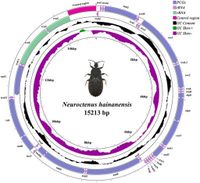In a groundbreaking study, researchers have sequenced and analyzed the mitochondrial genome of Neuroctenus hainanensis, revealing crucial insights into its evolutionary relationships within the Aradidae family of insects. The mitochondrial genome, which is 15,213 base pairs long, contains 37 genes and exhibits a distinct AT-rich bias that could offer explanations for the evolutionary dynamics of this group.
Published on March 20, 2025, this study highlights the significance of understanding mitochondrial genomes in the context of phylogenetics and has utilized second-generation sequencing technology for sequencing, assembling, and annotating the genome. Researchers found that the mitochondrial genome showcases an A + T content of 67.5% and an interesting structural arrangement that includes nine protein-coding genes (PCGs) and 14 tRNA genes located primarily on the majority strand, known as the J-strand.
Within the tRNA genes, the researchers discovered that the gene trnS1 lacks the typical DHU arm, forming a simple loop structure, while other tRNAs exhibit the cloverleaf structures expected of insect mitochondrial genes. The identification of such structural anomalies is crucial, as they can impact gene function and expression.
Phylogenetic analysis conducted in this study employed multiple datasets, confirming the relationships within the Aradidae family and the position of Aradoidea within the larger Pentatomomorpha group. The results indicated that N. hainanensis is closely related to the genus Mezira, thereby enriching the understanding of lineage diversification among these insects.
The study also provides evidence supporting the hypothesis that Aradoidea, which includes the Aradidae family, is a monophyletic group. The relationships determined through analyses categorized Aradoidea as the base of Pentatomomorpha, illustrating how evolutionary factors have shaped the lineage over time.
By concentrating on mitochondrial genomics, this research enhances frameworks for species identification and offers insights into the evolutionary biology of the Aradidae. As many species within this family are known agricultural pests, this foundational data could also inform pest management strategies in agricultural systems.
"This study is a step forward in understanding the evolutionary significance of the Aradidae family and explores their unique mitochondrial features," commented the authors of the article. They indicated that such genomic studies will aid in the broader examination of relationships in the Hemiptera order.
This new understanding of the mitochondrial genome characteristics of N. hainanensis not only emphasizes the relevance of mitochondrial genes in phylogenetic studies but also lays the groundwork for future research avenues in population genetics and ecological studies associated with these species.
As researchers continue to delve into the intricacies of insect gene sequences, discoveries like these will play a vital role in our comprehension of insect evolution and its implications for biodiversity and conservation efforts worldwide.




